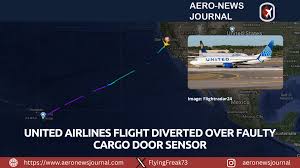Emergency Diversion: United Airlines Flight Diverted Due to Faulty Cargo Door Sensor
Emergency Diversion: United Airlines Flight Diverted Due to Faulty Cargo Door Sensor
By Favour | May 3, 2025
In a recent incident that brought both concern and praise for effective crisis management, United Airlines Flight 1731 made headlines after it was forced to divert mid-air due to a faulty cargo door sensor. The aircraft, a Boeing 777, was en route from Kona International Airport in Hawaii to Denver, Colorado, when the sensor issued an erroneous warning that one of the cargo doors might have been open.
While all passengers and crew members on board remained safe, the incident triggered a wave of public interest and scrutiny. Here’s a detailed look into what happened, how the airline and flight crew responded, and what the broader implications are for aviation safety.
—
The Incident in Detail
On April 29, 2025, United Airlines Flight 1731 departed Kona International Airport at approximately 1:30 p.m. local time with 360 passengers and 10 crew members aboard. The flight was scheduled to travel approximately 3,350 miles to Denver International Airport, a journey that typically takes about 7.5 hours.
Approximately three hours into the flight, while cruising over the Pacific Ocean, cockpit instruments signaled a possible malfunction: the cargo door sensor indicated that one of the aircraft’s cargo doors was open or improperly sealed. Although there were no physical signs of decompression or other danger, the flight crew immediately followed standard aviation protocol and decided to divert the flight to the nearest suitable airport.
At 4:58 p.m. local time, the Boeing 777 landed safely at San Francisco International Airport. Emergency responders were on standby, but no evacuation was necessary as the aircraft taxied safely to the gate and all passengers disembarked calmly.
—
What Caused the Diversion?
Preliminary reports suggest that the diversion was caused by a false sensor reading. Modern aircraft like the Boeing 777 are equipped with multiple redundant systems designed to alert pilots to potential hazards—including unsealed doors, landing gear issues, and cabin pressure anomalies.
In this case, the cargo door sensor gave a faulty signal. Engineers later confirmed that the door had been properly secured, and there was no breach or actual risk to the aircraft’s structural integrity. However, given the risks associated with a potential door failure at cruising altitude—where air pressure is vastly different from ground level—the crew had no choice but to act on the warning.
“We always err on the side of caution,” a United spokesperson said in a press release following the incident. “Our pilots are trained to make immediate safety decisions, and diverting the flight was the right course of action.”
—
Passenger Experience Onboard
According to several passengers who spoke to news outlets and shared their experiences on social media, the situation was handled with professionalism and calmness by the crew.
“At one point, we were cruising as normal, and then the captain announced that we had a technical issue and would be landing in San Francisco instead of Denver,” said one passenger. “There was no panic. Everyone was just relieved that the crew took the matter seriously and prioritized safety.”
Flight attendants reportedly walked through the cabin reassuring passengers, while the pilots maintained communication over the intercom, explaining the situation in real time.
—
FAA Involvement and Investigation
The Federal Aviation Administration (FAA) has launched a routine investigation into the matter, as is standard whenever a flight diversion occurs due to suspected mechanical or sensor-related issues. Maintenance logs, flight data, and crew reports will all be examined to determine whether the issue was a one-off failure or indicative of a broader pattern.
Although there is no indication of a systemic issue with Boeing 777 cargo door sensors, such investigations are vital to maintaining safety across the aviation industry.
“Even if it’s a false alarm, we need to understand why the system misfired,” said aviation analyst Greg Simmons. “If the sensor was malfunctioning, how often has this occurred before? Are other aircraft potentially at risk of similar false readings?”
—
A Reminder of Post-737 MAX Safety Culture
This event also comes at a time when the aviation industry is under heightened scrutiny following years of controversy surrounding Boeing’s 737 MAX aircraft and other mid-air safety incidents. Though the Boeing 777 has a long-standing reputation for reliability and performance, incidents like this serve as reminders of the constant vigilance required in commercial aviation.
Following the 737 MAX debacle, both airlines and regulators have doubled down on maintenance checks, software validations, and crew training. United Airlines, in particular, has invested heavily in predictive maintenance technologies that are supposed to identify and fix mechanical issues before they can impact flight operations.
“This situation proves both the strength and the weakness of our current system,” Simmons added. “The aircraft’s systems flagged a potential issue, and the crew responded perfectly. But we also see how a small sensor malfunction can cause widespread delays, extra fuel use, and stress for travelers.”
—
The Cost of Safety
Flight diversions are expensive. Between rerouting, fuel burn, and crew overtime, the cost of diverting a transpacific flight can easily exceed $100,000. Add to that the cost of rescheduling passengers, providing hotel accommodations if needed, and the potential loss of goodwill, and it’s clear that the financial implications are significant.
However, United Airlines has reaffirmed that passenger safety remains its number one priority—regardless of cost.
“Everything worked the way it should,” a senior United executive told media. “We diverted, we landed safely, and our people and passengers are safe. That’s always our end goal.”
—
Looking Ahead: Could AI Prevent This?
Some industry experts have suggested that AI and machine learning systems could be used to improve the accuracy of onboard sensor data. By analyzing multiple input streams—including temperature changes, aircraft vibration, and past sensor history—AI systems could, in theory, identify false positives before they prompt emergency actions.
But others caution that relying too heavily on AI could introduce its own risks. “There’s a fine line between innovation and overdependence,” said safety expert Rebecca Hall. “While AI can support human decisions, it should never override critical safety protocols.”
—
Conclusion
The diversion of United Airlines Flight 1731 may have disrupted the travel plans of 360 passengers, but it also demonstrated the robustness of modern aviation safety protocols. In an era when travelers expect not only efficiency but also transparency and trust, United’s swift and cautious response has been widely applauded.
With the FAA’s investigation ongoing, the incident may also serve as a catalyst for further improvements in sensor technology and fault detection. For now, the airline can take comfort in the fact that their investment in crew training, emergency procedures, and passenger care paid off when it mattered most.






